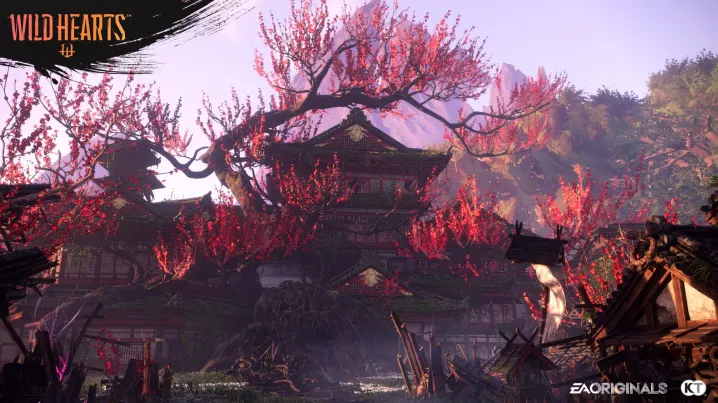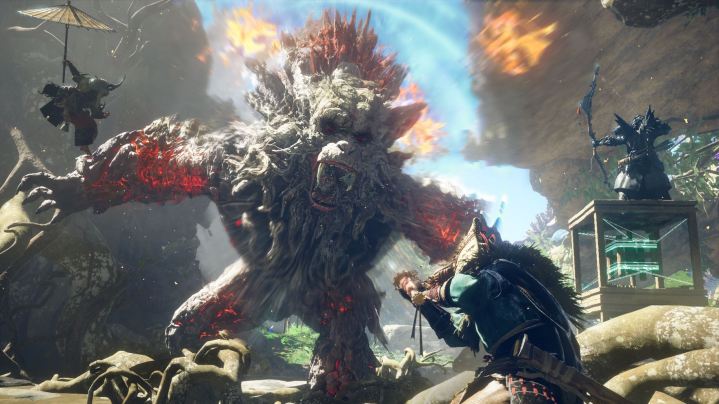The Koei Tecmo-developed and EA-published monster hunting game Wild Hearts, in which players hunt giant beasts called Kemono with the help of a magical piece of crafting technology called a Karakuri, left an impression on me when I played through its opening hours late last year. Now that I’ve had time to go hands-on with the final version of the game, I’m even more impressed with its philosophical approach to hunting and the impact it leaves on the environment. Rather than just serving as a hunting simulator or glorifying abuse toward animals, Wild Hearts highlights the balance between nature and life.
Wild Hearts‘ actual narrative is pretty by the numbers so far, its gameplay captivatingly portrays the relationship between humanity, animals, and nature in clever ways that elevate it over your standard hunting game. By showing players that they don’t always need to be aggressive, painting Kemono as deadly to the environment if left unchecked, and letting players asses the mark they leave on the game’s world, Wild Hearts shows more respect for nature and hunting than any other monster hunting game I’ve seen before in these opening hours.
The beauty of nature
In my preview of the game last year, I explained how Wild Hearts does a lot right in how it eases players into the genre much better than any Monster Hunter game. That said, it demonstrates its maturity and respect for nature with the first creature you encounter, a deer-like Kemono that is not aggressive. After getting the hang of the controls as you track it down, you can sneak up on it. You can kill the creature, but you can also choose to pet it and let it saunter away. It shows that not all Kemono need to be seen as prey, and you don’t necessarily need to hunt and kill everything you see.
You can encounter many nonviolent creatures while traveling through the region of Azuma, and killing them only nets you a meager amount of somewhat common resources. So far, I’ve avoided attacking these enemies, instead taking in the excellent environment and world design as I track down the biggest Kemono for me to fight. While Wild Hearts is made up of multiple smaller regions, not one big open world, Azuma’s locales still feel vast in scope, showing the overwhelming power of nature.

The first few areas I visited in Wild Hearts have all been beautiful and colorful, which encouraged me more to track down the Kemono that was interfering with this beautiful space.
The thrill of the hunt
Eventually, those fights against the giant Kemono do take place. These fall in the standard monster-hunting gameplay loop but still reinforce some of those more nuanced themes. Every Kemono you hunt appears to be corrupted by the environment in some way. Early game highlights include a giant hog covered in moss and vines and a giant gorilla constantly smoldering as it’s partially made of rocks and lava. These literal freaks of nature are all awe-inspiring, but you can tell that their presence is destructive to those beautiful environments you just had fun exploring.
The most powerful Kemono can change the environment just by walking through it, and the Kemono’s abilities to destroy or add objects to the environment reinforce their undeniable impact on nature. These battles are all very tough; neither nature nor any living being will roll over that easily. Kemono also retreats at multiple points during a fight, causing you to traverse and build more with your magical Karakuri technology in pursuit of them.
Whether I win or lose, at the end of a long fight, I gain respect for the journey that got me there and what it taught me about this Kemono’s place, unwelcome or not, in this environment.
Humanity’s impact on nature
After a long-winded Kemono fight, I found it quite revealing to look back at the battlefield and see the remnants of the encounter. In addition to the destruction the Kemono caused, some of my Karakuri builds remained, including temporary walls I built to protect myself or springs I used to jump away from the Kemono. Venturing to my next objective, I’m reminded of the camps, zip lines, and other more permanent Dragon Karakuri that now stain a once untouched landscape.

I can destroy these things if I want, but for a second, it reminds me of humanity’s impact on the environment. These Karakuri remnants are a hallmark of my gameplay efforts and a reminder that everything I do impacts the environment somehow. Intentional or not, the player freedom given the Karakuri crafting subtly reinforces the complicated relationship between life and nature in a standout way.
The ethics of hunting are certainly a contentious topic and do root Wild Hearts‘ genre in some inherent awkwardness. That said, it shows incredible respect for nature within the limits of its monster-hunting premise. So far, Wild Hearts feels more self-conscious than its competitors as it shows the terrifying beauty of nature, humanity, and technology. I’m excited to play more, see how this hunting evolves and expands, and find out of this respect sustains itself throughout the whole adventure.
Wild Hearts will launch for PC, PS5, and Xbox Series X/S on February 16.



